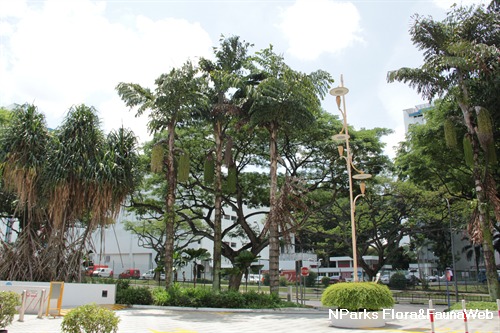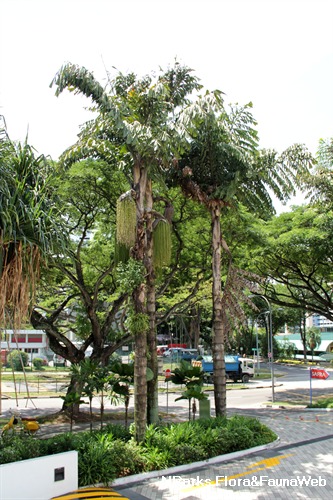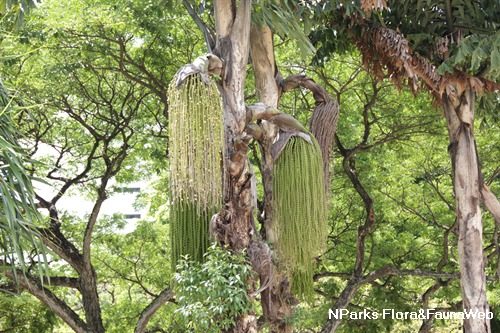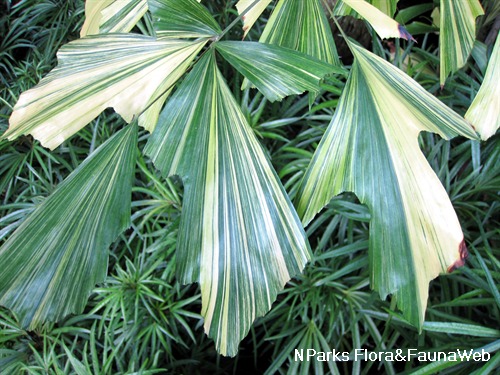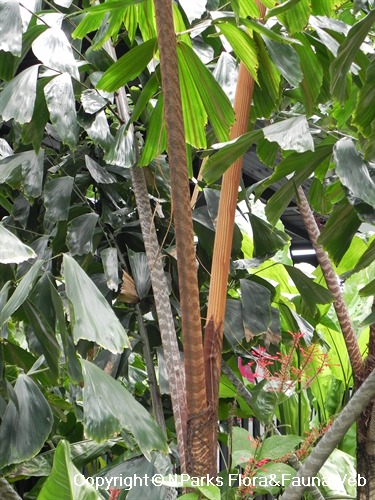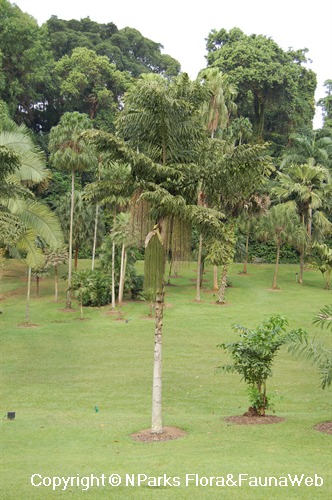_lowres.jpg)
Back
Caryota no Becc.
| Family Name: | Arecaceae (Palmae) |
| Synonyms: | Caryota rumphiana var. borneensis |
| Common Name: | Giant Fishtail Palm |
Name
Classifications and Characteristics
| Plant Growth Form | Palm (Solitary Habit) |
|---|
Biogeography
| Native Distribution | Borneo |
|---|
Description and Ethnobotany
| Growth Form | Hardy, fast-growing and naturally occurring in the rainforest of Borneo, it is a large, solitary, and majestic palm with a spectacular crown of huge, obliquely arching to horizontal fronds that have stiff, pendulous leaflets. This impressive giant is also one of the biggest of all the fishtail palms. |
|---|---|
| Trunk | Stem smooth, grey, stout, up to 0.7 m in girth, bulging in a manner reminiscent to that of Roystonea regia, ringed with prominent leaf scars; crownshaft absent. |
| Foliage | Fronds bipinnate, large, up to 4m long and 3 m wide; leaflets 20 to 30 cm in size, usually triangular or deltoid in shape with jagged edges. |
| Fruit | Fruits globular, about 2 to 4 cm in diameter, two-seeded, ripening from purple to black. |
| Others - Plant Morphology | Flower: Inflorescences cream, up to 2.5 m long; flowers occur in groups of 3 (2 males, 1 female). |
| Cultivation | Prefers full sun and moist, well-drained soil. Has high tolerance to full sun condition and high humidity. Can be grown indoors. Note: Flowering begins from the upper leaf axils and continue progressively downwards. The palm will die off once the last bunch in the lowest leaf axil has flowered and fruited. The duration of the whole flowering process will generally takes up to 7 years. Mature palms tend to be susceptible to basal fungal rot. Caution: Fruit is a irritant and is inedible as the pulp conatins calcium oxalate crystals which can result to irritation to the skin and muscous membranes.Propagate by seeds. Seeds germinate erratically, taking about 6 to 12 months. Seeds must be sown immediately after collection before they lose viability. |
| Etymology | The genus epithet 'Caryota' comes from the Greek 'caryon', a nut. The species epithet 'no' is derived from aboriginal name of the palm. |
| Ethnobotanical Uses | Others: The trunk contains a starch that can be used to make sago. The edible and delicious apical leaf bud (palm heart) is often harvested by the natives. |
Landscaping Features
| Landscape Uses | Suitable for Roadsides |
|---|
Plant Care and Propagation
| Light Preference | Full Sun |
|---|---|
| Water Preference | Moderate Water |
| Plant Growth Rate | Moderate |
Foliar
| Mature Foliage Colour(s) | Green |
|---|---|
| Mature Foliage Texture(s) | Glossy / Shiny |
| Foliar Shape(s) | Palm Fronds (Bipinnate) |
| Leaf Area Index (LAI) for Green Plot Ratio | 2.5 (Palm - Solitary) |
Non - Foliar and Storage
| Trunk Type (Palm) | Solitary Habit, Aboveground |
|---|
Floral (Angiosperm)
| Flower Colour(s) | Cream / Off-White |
|---|
Fruit, Seed and Spore
| Mature Fruit Colour(s) | Black |
|---|
Image Repository
Others
| Master ID | 1315 |
|---|---|
| Species ID | 2608 |
| Flora Disclaimer | The information in this website has been compiled from reliable sources, such as reference works on medicinal plants. It is not a substitute for medical advice or treatment and NParks does not purport to provide any medical advice. Readers should always consult his/her physician before using or consuming a plant for medicinal purposes. |

_lowres.jpg)
_lowres.jpg)
_lowres.jpg)
_lowres.jpg)
_lowres.jpg)
_lowres.jpg)
